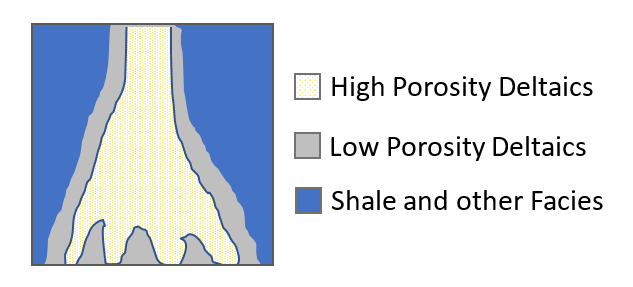
In the last couple of weeks in our 2020 Vision series we discussed porosity (the void space in the rock available for fluid) and hydrocarbon saturation (the percent of the void space filled with oil or gas) and how they relate to the question:
How much oil and gas are present?
Now that we understand the space available for hydrocarbons within the reservoir as defined by porosity (ɸ) and saturation (So), we need to define the volume of the producible reservoir. We will begin by looking at the parameter A (area).
Recall the simplified volumetric equation to calculate oil and gas resource:

The area of an oil and gas play is delineated by similar geologic facies (rock type, porosity, permeability, saturation, depositional history, and burial history). Geology is often quite complex and rock types can vary quickly from one location to another. Often there are lateral facies changes, perhaps as you go structurally up- or down-dip and travel to rocks that were laid down in a different energy environment. For example, in a basin setting, finer grained shales deposited in a lower energy environment are typically found down-dip (basinal) and coarser-grained clastics are found in a higher energy environment up-dip (closer to the shelf). When calculating reserves, the play concept is defined and the aerial extent of reservoir facies is determined.
Consider a conventional sandstone deltaic target. The play concept includes high porosity, high permeability sandstones deposited in a high energy deltaic environment. In the simplified map-view diagram below, the targeted facies is shown with light yellow dots. The reservoir area included in the resource calculation is the entire area projected to have the reservoir facies.

So how do we define the area with similar reservoir facies? Many tools are used. The top of a given rock unit or formation is mapped with a structure map (present-time depth), usually with the assistance of well log data. Depth reconstruction maps are created using geologic models and can show the structure of formations at the time of deposition. This can help us understand the environment that formations were deposited in (such as deep water, shallow water, lower energy, higher energy, etc.). Core samples can assist in measuring porosity, permeability, saturations, and understanding differences in rock type and composition from one location to another. Production data are also used to identify productive trends and correlate with geologic data. The boundary of productive trends corresponds to some change in geology, for example, a pinch-out (termination of facies), lateral facies change (change to a different rock type), structural change controlling saturation or maturation, or change in porosity.
We have now defined the pore space available for oil and gas, and the aerial extent of a productive trend as defined by similar reservoir facies. These are key components of resource assessment.

Thad Toups is the Owner and President of Haas Engineering. Founded in 1980, we’ve been providing reservoir engineering services and consulting for a vast array of companies in the energy space.

Recent Comments